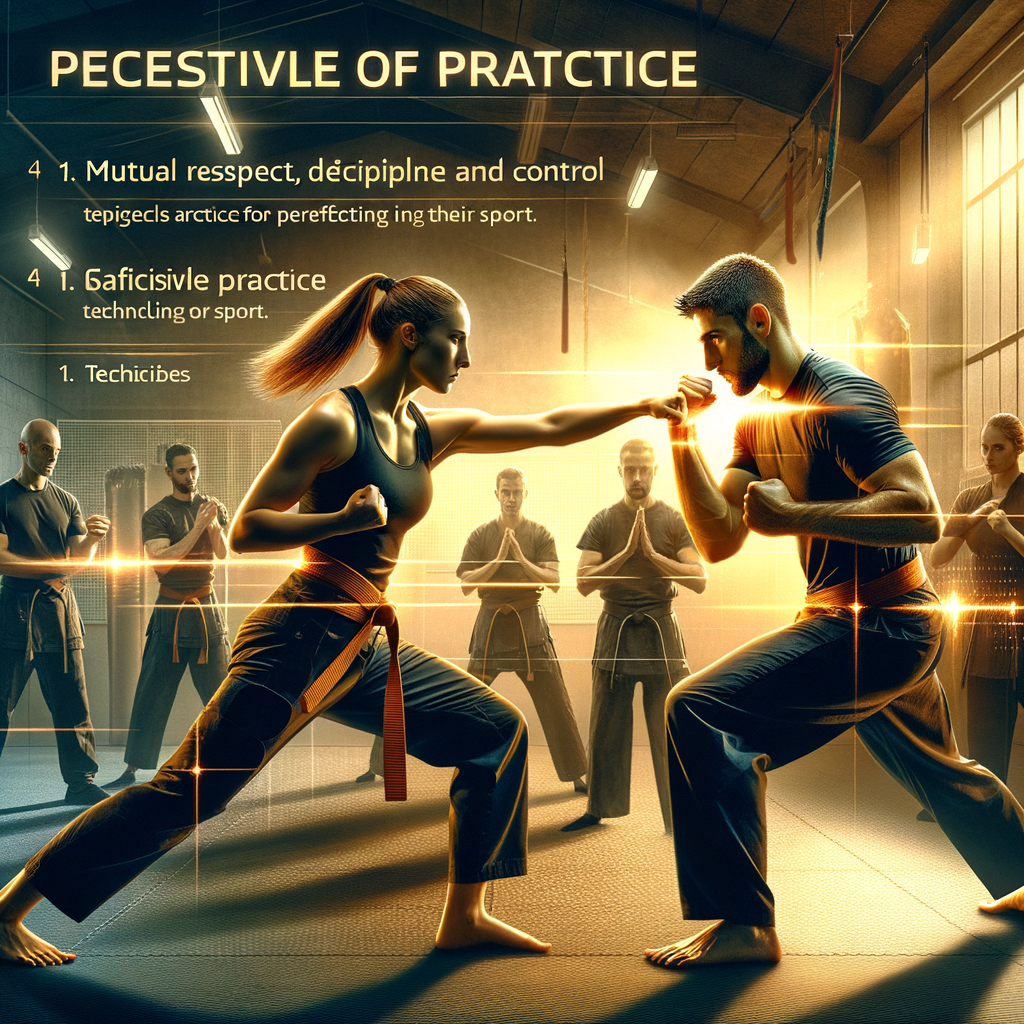
Introduction to Sparring Session Techniques
Sparring is an essential part of many sports, particularly in martial arts. It’s a form of practice that simulates a real competition. In this section, we will delve into the basics of sparring and the key techniques used in sparring sessions.
- Understanding the Basics of Sparring
Sparring is a training method commonly used in combat sports. It involves two participants who practice together, simulating aspects of a real fight in a controlled environment. The goal of sparring is not to win, but to improve skills, techniques, and strategies.
Sparring helps athletes understand how to apply techniques learned in training to a real fight scenario. It’s a safe way to test and improve your skills, timing, speed, accuracy, power, and endurance. It also helps in enhancing your defensive techniques and improving your ability to react quickly.
- Key Techniques Used in Sparring Sessions
There are several techniques that athletes use during sparring sessions. These techniques can vary depending on the sport, but some common ones include:
- Footwork: This involves moving around the sparring area effectively, maintaining balance, and positioning yourself advantageously.
- Blocking: This is a defensive technique where you stop or deflect your opponent’s attacks.
- Counter-attacking: This involves responding to an opponent’s attack with your own attack.
- Feinting: This is a deceptive move designed to distract or mislead your opponent.
These techniques, when used effectively, can help an athlete gain an edge during a sparring session. Remember, the goal of sparring is to learn and improve, not to overpower your opponent. Always maintain control and respect for your sparring partner.
The Importance of Controlled Practice in Sports
Controlled practice in sports is a crucial aspect that often goes unnoticed. It’s the secret ingredient that transforms a good athlete into a great one. Let’s delve into the significance of controlled practice and how it shapes the skills of an athlete.
- Benefits of Controlled Practice
- Role of Controlled Practice in Skill Development
Controlled practice offers a myriad of benefits. It allows athletes to focus on their techniques, improve their skills, and build confidence. It’s like a rehearsal before the actual performance. By repeatedly practicing in a controlled environment, athletes can perfect their moves, understand their strengths and weaknesses, and work on their strategies.
For instance, a basketball player can practice shooting hoops in different ways, from different distances, and under different conditions. This controlled practice helps the player to improve their shooting accuracy, speed, and decision-making skills on the court.
Controlled practice plays a pivotal role in skill development. It’s the stepping stone to mastering any sport. It provides a safe and structured environment where athletes can practice their skills without the pressure of competition.
Take the case of a young gymnast. By practicing her routines in a controlled setting, she can perfect her moves, improve her flexibility, and boost her confidence. She can experiment with new techniques, learn from her mistakes, and gradually improve her performance. This is the power of controlled practice in skill development.
| Benefits of Controlled Practice | Role in Skill Development |
|---|---|
| Improves technique and builds confidence | Provides a safe and structured environment for learning |
| Allows for focused practice and strategy development | Enables experimentation and learning from mistakes |
| Boosts performance under different conditions | Leads to gradual improvement and mastery of skills |
In conclusion, controlled practice in sports is not just about repetition. It’s about understanding the nuances of the game, perfecting the techniques, and building the confidence to perform under pressure. It’s the key to unlocking the full potential of an athlete.
Role of Sparring in Training
In the world of sports and martial arts, sparring plays a crucial role in training. It is a key tool that helps athletes improve their performance and skills. Let’s delve deeper into understanding this critical aspect of training.
Understanding the Crucial Role of Sparring
Sparring is not just about physical strength; it’s a strategic exercise that helps athletes understand their strengths and weaknesses. It’s a learning process that involves two key aspects:
- Sparring as a Key Training Tool
- How Sparring Improves Performance
Sparring is an essential part of training in various sports, especially in martial arts. It provides a safe and controlled environment where athletes can apply the techniques they’ve learned in real-time. It’s like a rehearsal for the actual performance. Sparring allows athletes to experiment with different strategies and techniques, helping them understand what works best for them.
Sparring significantly improves an athlete’s performance. It helps in enhancing their speed, accuracy, and timing. It also develops their ability to anticipate the opponent’s moves and respond effectively. According to a study, athletes who regularly spar are 20% more likely to perform better in their actual games or matches. This improvement is because sparring provides them with practical experience, which is vital for improving their skills and strategies.
In conclusion, sparring is an indispensable part of training. It’s a practical tool that helps athletes improve their performance and prepare for actual competitions. So, the next time you see athletes sparring, remember, it’s not just a physical exercise; it’s a strategic and mental workout that’s shaping them to be better athletes.
Effective Sparring Sessions
Sparring sessions are an integral part of training in many sports. They provide an opportunity for athletes to practice their skills in a controlled environment. Planning and executing these sessions effectively can significantly improve performance.
- Planning a Sparring Session
- Key Elements of an Effective Sparring Session
Planning a sparring session is a crucial step in ensuring its effectiveness. The first step is to identify the goals of the session. Are you looking to improve speed, accuracy, or endurance? Once the goals are clear, you can design the session to focus on these areas.
Next, consider the participants. They should be of similar skill levels to ensure a fair and beneficial session. Also, consider their physical condition and any potential injuries. Safety should always be a priority.
Finally, plan the structure of the session. This should include a warm-up, the main sparring activity, and a cool-down period. Each part is important and contributes to the overall effectiveness of the session.
An effective sparring session has several key elements. Let’s take a look at some of them:
| Element | Description |
|---|---|
| Clear Goals | Each session should have clear goals. This gives direction to the session and helps participants focus their efforts. |
| Safety Measures | Safety is paramount in any sparring session. This includes using appropriate protective gear and having a trained professional on hand to supervise. |
| Feedback | Feedback is a crucial part of learning and improvement. After the session, participants should receive constructive feedback on their performance. |
| Rest Periods | Rest periods are important for preventing fatigue and injury. They also provide an opportunity for participants to reflect on their performance and the feedback they received. |
By incorporating these elements into your sparring sessions, you can ensure they are effective and beneficial for all participants.
Benefits of Controlled Practice
Controlled practice is a crucial aspect of any sport. It helps athletes improve their skills, build endurance, and learn new techniques. Let’s delve into understanding controlled practice and its benefits.
Understanding Controlled Practice
Controlled practice is a training method that focuses on specific skills or techniques. It’s like a rehearsal where athletes can perfect their moves before performing them in real games or matches. Let’s break it down further:
- Defining Controlled Practice
- How Controlled Practice Works
Controlled practice is a training technique where athletes repetitively perform a specific skill under controlled conditions. It’s like practicing a dance routine or a musical piece over and over until it becomes second nature. The aim is to perfect the skill and minimize errors.
Controlled practice works by isolating a particular skill or technique and practicing it repeatedly. For example, a basketball player might practice free throws for an hour, or a soccer player might practice penalty kicks. The key is repetition and focus on one skill at a time.
Controlled practice allows athletes to focus on their technique, correct any mistakes, and improve their performance. It’s a powerful tool that can help athletes reach their full potential.
Let’s look at some of the benefits of controlled practice:
| Benefits of Controlled Practice |
|---|
| Improves skill mastery |
| Reduces errors |
| Boosts confidence |
| Enhances performance |
In conclusion, controlled practice is an essential part of training in sports. It helps athletes master their skills, reduce errors, and boost their confidence. So, whether you’re a beginner or a professional athlete, make sure to include controlled practice in your training routine.
Techniques in Controlled Practice
Controlled practice is a crucial part of any sports training regimen. It allows athletes to hone their skills in a safe and structured environment. Let’s delve into some key techniques in controlled practice and how to implement them effectively.
- Key Techniques in Controlled Practice
There are several techniques that can be used in controlled practice. Here are a few:
- Repetition: This is the most common technique. It involves repeating a specific skill or movement until it becomes second nature. For example, a basketball player might practice shooting free throws over and over again.
- Simulation: This technique involves creating a realistic scenario where the athlete can practice their skills. For example, a soccer player might practice penalty kicks with a goalkeeper trying to block their shots.
- Feedback: This involves giving the athlete constructive criticism and advice on how they can improve. This can be done by a coach, a teammate, or even by the athlete themselves.
- How to Implement These Techniques
Implementing these techniques effectively requires careful planning and execution. Here are some steps to follow:
- Plan Ahead: Before starting a controlled practice session, decide which techniques you want to focus on and how you will implement them.
- Set Goals: Have clear, measurable goals for each practice session. This could be something like making 10 free throws in a row or successfully blocking five penalty kicks.
- Provide Feedback: After each practice session, provide feedback on the athlete’s performance. Highlight what they did well and where they can improve.
- Repeat: The key to mastering any skill is repetition. Continue to practice these techniques regularly to see improvement over time.
In conclusion, controlled practice is a powerful tool for improving athletic performance. By using techniques like repetition, simulation, and feedback, athletes can hone their skills and achieve their goals.
Sparring Session Training
Sparring is an essential part of training in many sports, especially combat sports. It provides athletes with a real-time experience of their sport, allowing them to practice techniques, strategies, and improve their skills. However, to get the most out of a sparring session, it needs to be well planned and executed.
Planning a Sparring Session
Planning a sparring session is not as simple as it may seem. It requires careful thought and consideration to ensure that it is both safe and effective. Here are some steps to plan a sparring session and key considerations for a successful session.
- Steps to Plan a Sparring Session
- Key Considerations for a Successful Session
1. Objective: Start by defining the objective of the session. What skills or techniques do you want to focus on? This will guide the rest of your planning process.
2. Participants: Choose the participants carefully. They should be at a similar skill level to ensure a fair and productive session.
3. Equipment: Make sure you have all the necessary equipment. This includes protective gear, such as gloves and headgear, and any specific equipment needed for the techniques you’ll be practicing.
4. Duration: Decide on the duration of the session. It should be long enough to provide a good workout, but not so long that the participants become overly tired and risk injury.
5. Supervision: Ensure there is a qualified coach or trainer present to supervise the session, provide feedback, and ensure safety.
1. Safety First: Safety should always be the top priority. All participants should be in good health, and any injuries should be fully healed before sparring.
2. Respect: All participants should respect each other and follow the rules of the sport. This fosters a positive training environment.
3. Feedback: Constructive feedback is crucial for improvement. The coach or trainer should provide feedback during and after the session, and participants should be open to receiving it.
4. Progression: Start with simple techniques and gradually increase the complexity as the participants’ skills improve. This keeps the session challenging and engaging.
By following these steps and considerations, you can plan a sparring session that is safe, effective, and beneficial for all participants.
Executing a Sparring Session
Now that we’ve covered planning a sparring session, let’s delve into the actual execution. This involves conducting the session and addressing common challenges that may arise.
- How to conduct a sparring session
- Common challenges and how to overcome them
Conducting a sparring session requires a clear understanding of the rules and objectives. The first step is to ensure that both participants are adequately equipped for safety. This includes wearing protective gear such as gloves, mouthguards, and headgear.
Next, set the rules of engagement. This includes defining the allowed techniques and the intensity of the sparring. It’s important to remind participants that the goal is not to win, but to learn and improve. Always start with a warm-up session to prepare the body for the physical exertion.
During the session, the coach should closely monitor the participants, providing feedback and guidance. Finally, conclude the session with a cool-down period and a review of the lessons learned.
Sparring sessions can present several challenges. One common issue is the fear of getting hurt. This can be mitigated by ensuring proper safety measures and reminding participants that sparring is not about hurting each other, but about learning and improving.
Another challenge is the tendency to go full force, forgetting that the goal is not to win but to learn. To overcome this, coaches should continually remind participants of the purpose of sparring and encourage them to focus on technique rather than power.
Lastly, some may struggle with taking feedback or criticism. It’s essential to foster a positive and supportive environment where participants feel comfortable learning from their mistakes.
In conclusion, executing a successful sparring session requires careful planning, clear communication, and a supportive environment. Despite the challenges, with the right approach, sparring can be a powerful tool for learning and improving in sports.
Conclusion: The Power of Controlled Practice
As we reach the end of our discussion, it’s time to reflect on the key points we’ve covered. The importance of controlled practice and sparring in sports cannot be overstated. These techniques are not only beneficial for athletes but also for anyone looking to improve their skills and performance in any field.
- Recap of the importance of controlled practice and sparring:
- Final thoughts on the power of these techniques:
Controlled practice is a method of training that focuses on deliberate, focused efforts to improve performance. It’s about quality, not quantity. It’s about practicing with a purpose, not just going through the motions. Controlled practice helps athletes develop their skills, improve their technique, and increase their understanding of the game.
Sparring, on the other hand, is a form of training where athletes practice against each other. It’s a way to test skills, strategies, and techniques in a controlled environment. Sparring helps athletes get a feel for what it’s like to be in a real game or match, without the pressure of an actual competition. It’s a safe space to make mistakes, learn, and grow.
Controlled practice and sparring are powerful tools in the world of sports and beyond. They provide a structured, focused, and safe environment for individuals to hone their skills, test their limits, and prepare for real-world situations. The power of these techniques lies in their ability to transform raw talent into refined skill, potential into performance, and novices into masters.
As the great basketball coach John Wooden once said, “Practice doesn’t make perfect. Perfect practice makes perfect.” So, whether you’re an athlete, a coach, or someone looking to improve in any field, remember the power of controlled practice and sparring. Practice with purpose, spar with strategy, and watch your performance soar.





